
Trophallaxis is the transfer of food or other fluids among members of a community through mouth-to-mouth (stomodeal) or anus-to-mouth (proctodeal) feeding. Along with nutrients, trophallaxis can involve the transfer of molecules such as pheromones, organisms such as symbionts, and information to serve as a form of communication. Trophallaxis is used by some birds, gray wolves, vampire bats, and is most highly developed in eusocial insects such as ants, wasps, bees, and termites.

Hornets are the largest of the eusocial wasps, and are similar in appearance to yellowjackets, their close relatives. Some species can reach up to 5.5 cm (2.2 in) in length. They are distinguished from other vespine wasps by the relatively large top margin of the head. Worldwide, 22 species of Vespa are recognized. Most species only occur in the tropics of Asia, though the European hornet is widely distributed throughout Europe, Russia, North America, and north-eastern Asia. Wasps native to North America in the genus Dolichovespula are commonly referred to as hornets, but all of them are actually yellowjackets.
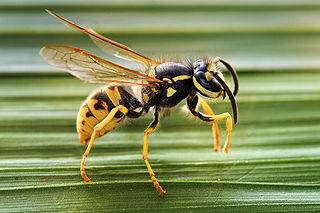
The Vespidae are a large, diverse, cosmopolitan family of wasps, including nearly all the known eusocial wasps and many solitary wasps. Each social wasp colony includes a queen and a number of female workers with varying degrees of sterility relative to the queen. In temperate social species, colonies usually last only one year, dying at the onset of winter. New queens and males (drones) are produced towards the end of the summer, and after mating, the queens hibernate over winter in cracks or other sheltered locations. The nests of most species are constructed out of mud, but polistines and vespines use plant fibers, chewed to form a sort of paper. Many species are pollen vectors contributing to the pollination of several plants, being potential or even effective pollinators, while others are notable predators of pest insect species, and a few species are invasive pests.

Vespula is a small genus of social wasps, widely distributed in the Northern Hemisphere. Along with members of their sister genus Dolichovespula, they are collectively known by the common name yellowjackets in North America. Vespula species have a shorter oculomalar space and a more pronounced tendency to nest underground than Dolichovespula.

Paper wasps are a type of vespid wasps. The term is typically used to refer to members of the vespid subfamily Polistinae, though it often colloquially includes members of the subfamilies Vespinae and Stenogastrinae, which also make nests out of paper.

The European hornet is the largest eusocial wasp native to Europe. It is also the only true hornet found in North America, having been introduced to the United States and Canada from Europe as early as 1840. Vespines, such as V. crabro, are known for making intricate paper-like nests out of surrounding plant materials and other fibers. Unlike most other vespines, reproductive suppression involves worker policing instead of queen pheromone control, as was previously thought.

The median wasp is a species of social wasp of the family Vespidae found throughout Europe and Asia. It builds aerial paper nests often in shrubs or trees, and occasionally under the eaves of buildings. It is most common to see this wasp between May and October during its 3.3 month colony cycle. Behaviours of this wasp include nest defense, curling which is believed to function in brood incubation, and gastral vibration which is involved in larval feeding. The median wasp has a halplodiploid sex determination system that results in a high level of relatedness within the colony. This species is not usually aggressive but will sting if they feel their nest is threatened. Most foraging in the nest is done by the workers once the first ones reach adulthood. These workers forage for insects, nectar, and wood for nest construction in temperatures as low as 7 °C (45 °F). The median wasp is known to be occasionally affected by the fungus Cordyceps sphecocephala and the Cricket paralysis virus.

Vespula germanica, known colloquially as the European wasp, German wasp, or German yellowjacket, is a species of wasp found in much of the Northern Hemisphere, native to Europe, Northern Africa, and temperate Asia. It has spread and become well-established in many other places, including North America, South America, Australia, South Africa, and New Zealand. German wasps are part of the family Vespidae and are sometimes mistakenly referred to as paper wasps because they build grey paper nests, although strictly speaking, paper wasps are part of the subfamily Polistinae. In North America, they are also known as yellowjackets.
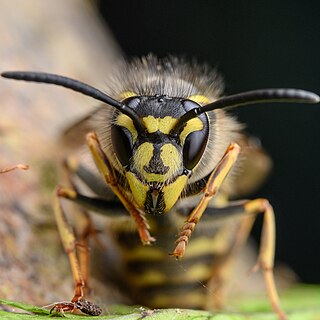
Vespula vulgaris, known as the common wasp, is a species found in regions that include the United Kingdom, Ireland, Germany, India, China, New Zealand and Australia. It is sometimes known in English as the European wasp, but the same name is used for the species Vespula germanica or German wasp. In 2010, the ostensible Vespula vulgaris wasps in North America were found to be a different species, Vespula alascensis.

A wasp is any insect of the narrow-waisted suborder Apocrita of the order Hymenoptera which is neither a bee nor an ant; this excludes the broad-waisted sawflies (Symphyta), which look somewhat like wasps, but are in a separate suborder. The wasps do not constitute a clade, a complete natural group with a single ancestor, as bees and ants are deeply nested within the wasps, having evolved from wasp ancestors. Wasps that are members of the clade Aculeata can sting their prey.
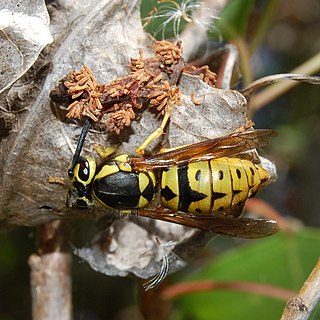
Vespula pensylvanica, the western yellowjacket, is a Nearctic species of wasp in the genus Vespula. It is native to regions of North America, largely in areas with northern temperate climates. Its reproductive behavior is constrained by cold weather, which successfully reduces the number of western yellowjackets in cold months. However, in the absence of cold weather, this wasp's population can explode. The western yellowjacket has become particularly invasive in the Hawaiian Islands, resulting in their label as a major pest.

The eastern yellow jacket or eastern yellowjacket is a wasp found in eastern North America. Although most of their nests are subterranean, they are often considered a pest due to their nesting in recreational areas and buildings. This yellow jacket is a social insect, living in colonies of hundreds to thousands of individuals. Along with their subfamily, Vespinae, this species demonstrates supportive parental care for offspring, separation of reproductive and sterile castes, and overlapping generations. They aggressively defend their hives from threats and are known to inflict painful stings.

Vespa luctuosa is a species of hornet which is endemic to the Philippines. The main subspecies is Vespa luctuosa luctuosa. Other known subspecies include Vespa luctuosa luzonensis and Vespa luctuosa negrosensis. Vespa luctuosa is known for its potent venom.

Vespula rufa, commonly known as the red wasp, is a social wasp species belonging to the genus Vespula. It is found in northern and central Europe and parts of Asia. Vespula rufa is characterised by red-brown markings and body segmentation, with the appearance varying amongst the different roles of individuals in the species. These wasps build small nests in dry banks underground that are not far below the surface. The colony cycle begins in the fall. Vespula rufa feed on live insects. One interesting fact about Vespula rufa is that the queen policing occurs in the species, and that worker policing occurs at much lower rates than other species in the genus Vespula. There are predators and parasites of the species. The species goes through a series of events before leaving the nest.
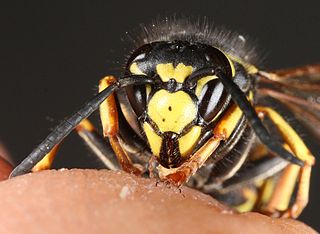
Vespula austriaca is an obligate parasitic wasp, parasitizing the nests of other species in the genus Vespula in the Old World. Its common host species include V. rufa in Europe, Japan, and East Siberia.V. austriaca wasps pollinate orchids.
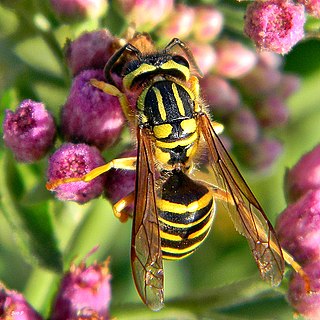
Vespula squamosa, or the southern yellowjacket, is a social wasp. This species can be identified by its distinctive black and yellow patterning and orange queen. This species is typically found in eastern North America, and its territory extends as far south as Central America. Within these territories, they create enormous, multiple-comb nests. The colonies may be either annual or perennial depending on the climate, and in many perennial nests, polygyny takes place. In addition, this species uses pheromones both as a sexual attractant and an alarm signal. This species feeds on insects and animal carcasses; it does not produce honey. V. squamosa, a social insect, has developed a parasitic relationship with the species V. vidua and V. maculifrons. Due to their painful, venomous stings, the species is considered a pest.

Dufour's gland is an abdominal gland of certain insects, part of the anatomy of the ovipositor or sting apparatus in female members of Apocrita. The diversification of Hymenoptera took place in the Cretaceous and the gland may have developed at about this time as it is present in all three groups of Apocrita, the wasps, bees and ants.

Vespula atropilosa, also known as the prairie yellowjacket, is a black and yellow social wasp that forms annual colonies. Vespula atropilosa was formerly a member of the Vespa family. Males have either xanthic (yellow) or melanic (black) abdominal coloring. The prairie yellowjacket can be found in the Western and Midwestern United States as well as parts of southern Canada. It builds its nests underground and prefers large open areas such as pastures and golf courses. Vespula atropilosa colonies are founded by a queen in the spring and grow most during mid-summer. It preys on other insects such as flies and grasshoppers but is not a scavenger like other wasps. Queens mate with multiple males, and males will fight each other for matings. V. atropilosa is a social wasp that practices altruism. Prairie yellowjackets are not considered pests but are commonly found in backyards in the Pacific Northwest. This species derives its common name from the prairies and grasslands where it can be found.

Vespula infernalis is an obligate parasitic wasp, parasitizing the nests of other species in the genus Vespula. Its common host species is V. acadica in North America. It is sometimes called the cuckoo yellowjacket wasp due to its inquiline lifestyle. They differ from other parasitic wasps in their intensely aggressive behaviour during invasion and occupation of the host colony. Several morphological adaptations such as bigger body parts and highly curved stingers are present in these wasps to aid their aggressive parasitic behaviour.

Vespa analis, the yellow-vented hornet, is a species of common hornet found in Southeast Asia.





















